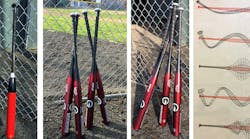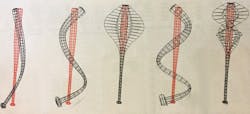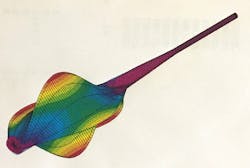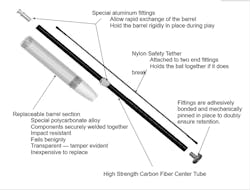Download this article as a .PDF
Back in 1995, a business colleague challenged me to design a high-performance composite softball bat. At the time, hollow aluminum bats were the most common, with major sports manufacturers offering a few high-performance (and expensive) titanium bats. Composite bats had been tried, but they were generally too stiff and their performance (as measured by hit distance) of no interest to top players. Wooden bats were still available but limited in use to Major League Baseball.
Analyzing Bats
As noted, hollow bats were the standard for softball, and their performance—which was better than that of solid wooden bats—was attributed to the “trampoline effect.” This term refers to the hoop-wise distortion and spring-back of the barrel section of hollow bats, something that gives a little more “pop” to the impact. Industry wisdom was “thinner is better,” and few people had a deep understanding of the physics behind this trend.
It seemed reasonable to believe that the frequency of one or more of a bat’s vibration modes might have some relationship to performance. As a test of that hypothesis, my team gathered up a dozen bats whose relative performance was known and sent them to an outside firm for vibration analysis. These bats included a range of manufacturers, models, construction materials, and player leagues (as shown in the table).
Testing analysis revealed that all bats shared a similar general shape for the first five modes of vibration, with modes 1, 2, and 4 being axial bending ,while modes 3 and 5 are hoop flexing.
Testing a dozen different bats revealed that they all share similar vibrational modes. Modes 1, 2, and 4 from the top are axial bending modes. Modes 3 and 5 are hoop flex modes.
Further analysis identified a very strong correlation between the first hoop mode (which is mode 3) and bat performance, with lower vibrational frequencies generally correlating to higher performance—something we described as constructive recovery of the hoop distortion in synchronization with ball/bat interaction. Another way to think of it is that lower frequencies correlate with softer barrel structures and easier distortion of the barrel wall.
Bats which distort easily in the hoop mode minimize deformation of the ball itself. And since ball deformation is usually much more highly damped and energy absorbing than deformation of the bat, more energy is conserved in the interaction (i.e., when the bat and ball collide).
So, the key to designing a good bat was to ensure that its hoop frequency had the hoop deflection fully recovering just as the ball was leaving. This was important. It gave us a design parameter easily evaluated using FEA and one we could optimize to get the best performing composite bat. But hoop stiffness is driven by a combination of composite fiber type, fiber orientation, ply stack thickness, and ply order within the stack. So, there were still there were a lot of variable to juggle to get both high performance and durability.
Here is an FEA plot of the higher-order hoop vibrational mode of a bat.
We wrote two patents to protect this design idea and proceeded to make our first prototypes.
Prototype Development and Product Approval
The design guidance—to focus on hoop frequency—worked great, and we immediately began turning out composite bats with performance characteristics as good as any aluminum bat on the market. The problem we immediately encountered, and one that continued to haunt us, was durability. We consulted closely with a composites engineer who had experience in designing impact resistant structures for the aerospace industry, but it turns out most of that industry’s experience is with unintended impacts, such as a wrench dropped on a composite wing skin.
We, on the other hand, were dealing with repeated impacts, all violent in nature, and generally occurring at the same spot. It was an incredibly demanding design condition for a composite structure, especially given a market-driven requirement that the bat withstand at least 500 impacts before failure. Importantly, this number was driven by the anticipated number of at-bats a league player might expect in a single season and was tied to the industry warranty standard of “one year, one replacement.”
We tried several different fiber combinations, eventually settling on one involving high angle (close to circumferential in orientation) fiberglass for hoop performance, low-angle carbon for axial bending stiffness, and aramid for general toughness and vibration damping. We also selected a tough epoxy resin developed by Dow Chemical to hold everything together and specified fiber sizing agents developed to enhance fiber/matrix adhesion for that epoxy. After months of effort, we finally got the go-ahead from our marketing partner, Hillerich & Bradsby, and launched production of a bat designated Genesis SB34 (a name that mysteriously emerged from the marketing department at H&B) using a manufacturing plant we setup in Guadalajara, Mexico.
Production and Market Success
The bat consisted of a complex filament-wound preform that was resin transfer molded (RTM) using heated steel tooling. Production required several molds, oil heaters, hydraulic presses, resin-injection equipment, painting facilities, a screen-printing press, and lots of people.
Getting the painted finish right proved to be one of the most difficult and time-consuming parts of the development process. The paint would not remain firmly attached and looking good after the impacts and abuse any bat endures on the playing field. That problem was also eventually solved, thanks to a custom urethane paint over an epoxy compatible primer—a combination recommended by a specialty paint manufacturer—and product began to flow.
The good news? The market success was immediate. The Genesis SB34 quickly became one of the most sought-after bats in slow-pitch softball and won the award for “Best Overall Performance” at the 2001 “Bat Wars” competition hosted by Softball Magazine. For reasons that were not immediately clear, even though the SB34 was certified to the same performance standard as top aluminum bats (a Bat Performance Factor of 1.20), its performance in the field was noticeably and dramatically better than the best aluminum bats.
The American Softball Assoc. eventually commissioned a team from Washington State University under Dr. Lloyd Smith (ssl.wsu.edu) <<The team also found that composite laminates “softened” as the matrix holding all the fibers together aged and developed a network of micro-cracks. This softening had the same effect as making the wall thinner and increasing the trampoline effect.
What followed from WSU’s investigation was a series of new test requirements that have created major limitations on composite bat performance. One such standard involves the “Batted Ball Coefficient of Restitution” (BBCOR). It regulates how much energy is lost during the bat's contact with the baseball. These tests work and have made the game safer, especially for pitchers and in-fielders.
The Dark Side
The bad news in the Genesis story is that durability continued to be an issue and return rates for failed bats within the one-year warranty period hovered near 80%. One explanation suggested that because the bat was quite expensive for the time (around $250 in 2001), it may have been common for one person to buy a bat and then let the entire team use it. If so, assumptions about the maximum number of impacts expected during a single season, a critical part of the design and acceptance stage of the bat, significantly underestimated actual use.
There was also speculation that some buyers would treat the bat in unanticipated ways to ensure it failed before the 12-month warranty period elapsed and then return the bat for a no-questions replacement. The bat was redesigned in 2002 by increasing the wall thickness slightly and increasing fiber angles (closer to circumferential) to increase durability. This led to small cost in performance, but it wasn’t enough. Return rates remained high. To make matters worse, its success in the market encouraged other major manufacturers to enter the composite market, and they did so with some superb products. Easton’s was particularly good. By 2003, the end was clear and proved to be ugly, but that story must remain untold.
A New Beginning
In the wake of this failure, and a recognition that all bats eventually fail if designed for the competitive levels of performance demanded by users, it was obvious new approaches were needed. The industry, as a whole, has agreed. For example, Easton’s current warranty currently reads:
“This is a high-performance product, designed to deliver maximum performance within the limits of the association rules. In order to deliver peak performance, this bat is not indestructible. In fact it’s useful life is partly determined by the number of hard hits it takes over its lifetime. For this reason, our bats are designed with the intent of individual use. They are not designed to be a team bat.
“Easton reserves the right to refuse warranty service to any person who, in the sole discretion of Easton, abuses the products and/or our warranty policy.”
To their credit, manufacturers have also found ways to improve composite durability using different fiber combinations, laminate construction, and tougher resins. These changes have come about gradually and changes in ASA, USSSA, Senior Softball, and Little League rules that mostly reduce performance limitations have helped.
At one time, in need of an immediate fix, we envisioned a replaceable barrel bat, one in which a relatively inexpensive barrel/impact section could be replaced without also replacing the more expensive composite handle and retention hardware. We built several prototypes based on a carbon fiber handle which passed completely through a composite barrel and transition section (shown in the illustration). We filed three patents and started searching for a new partner.
The replaceable barrel design was eventually licensed to Worth Sports and they spent another year in development. In the meantime, Worth was purchased by K2 Sports, which also purchased the Rawlings and Miken brands (the latter in November 2004), and a replaceable barrel bat, the “Revolver,” was released under the Miken trademark.
The Revolver package consisted of a short handle and two high-performance composite barrels, all packaged in a nice travel kit. The retail price exceeded $600. Less than 2,000 units were sold, and the product was discontinued within a year.
One manufacturer did market a bat with a replaceable carbon-fiber barrel. It cost $600 and was on the market for only a year.
The Rise of Plastics
Clearly a lower-priced option was needed. One solution that sounded attractive, but came with a lot of challenges, was the idea of a plastic-barrel bat. Couldn’t something as tough as polycarbonate, touted as “bulletproof,” work in a softball bat barrel?
We decided to pursue the idea of an extruded thermoplastic barrel joined with injection molded end cap and transition pieces, ideally using a transparent plastic alloy. There were many perceived advantages. First, it would be inexpensive and highly scalable in manufacturing. Second, there were some amazing opportunities for developing see-through graphics, florescent colors, and other special effects. Third, early testing revealed that plastics’ lower elastic modulus could be combined with thicker walls while still applying old design rules governing hoop vibrations to create more durable, high-performance bats. And finally, the low-density plastic, almost half that of a composite laminate, could easily lead to the lightweight bats needed for Fast Pitch and youth baseball.
Two problems had to be overcome. At first, every plastic tried, even polycarbonate, eventually failed due to impact fatigue. These failures were catastrophic, with plastic shards flying everywhere—a safety issue that could not be tolerated. Players also reported a minor level of vibration being transmitted to their hands when they hit the ball.
The first problem was solved when we finally discovered a polycarbonate-siloxane copolymer. Its unique properties let it endure hundreds of impacts and then fail benignly, with small cracks developing and growing, but never a catastrophic failure. Finding this plastic and identifying its best alloy within that family took months and many prototype tests. It also illuminated the need for new test methods because normal impact characteristics, those derived from Izod and Charpy tests, did not address a material’s ability to withstand repeated impacts. Like many such developments, the critical insight was born out of a chance conversation with a researcher who mentioned the increase in toughness for any polymer as its molecular weight grows. He described it as analogous to spaghetti—the longer the molecules, the more entangled they become and the harder they are to separate.
The search was not without drama, as our original plastics manufacturer withdrew from the baseball market just as we were considering a launch, citing concerns about product liability. Fortunately, we found a foreign supplier of the copolymer willing to proceed.
The second problem, reported vibrations during a ball strike, remains an issue. We believe we understand the root cause, low axial stiffness of the bat, but without corporate support and given our decision to pursue a low-risk development strategy, we don’t have the funding to proceed. (This is obviously one of the major downsides to the low-risk development strategy I’ve repeatedly advocated.)
We continue to believe that replaceable plastic barrel technology represents a disruptive technology for the sport, one players (especially young players) have overwhelmingly endorsed. The “cool” factor of a transparent barrel has been amazing. The Catch-22 is that established bat manufacturers have no incentive to introduce this technology. Why sell an inexpensive replaceable barrel component when you can sell a whole bat at several times the price? The only path forward would be an independent offering, much like what Ray DeMarini did in 1989 when he introduced a double-wall bat that revolutionized the sport. That’s a “lay it all on the line” development strategy that we’ve been unwilling to pursue.
What’s Left?
In the absence of an independent manufacturing launch, we have continued to promote the use of this amazing polycarbonate-siloxane copolymer for other uses in baseball and softball bats. For example, there is an opportunity to combine this thermoplastic tubing with standard bat construction in a variety of ways to tune bat performance so that it does not change easily over time or with repeated impacts. This polymer, unlike a composite laminate, is isotropic—i.e., its material properties are essentially the same in all directions. Additionally, it does not have a laminate structure, so it does not delaminate, and softening (if there is any) is greatly reduced. Designing all bats to perform more like wooden bats (as is being driven, for example, by Little League rules) is possible by combining composites and this plastic, but without the weight of wood or the dangers of broken and splintering wooden bats.
We recently applied for a U.S. patent based on this technology and are working with one U.S. bat manufacturer to explore a range of opportunities. Other inquiries are always welcome.





